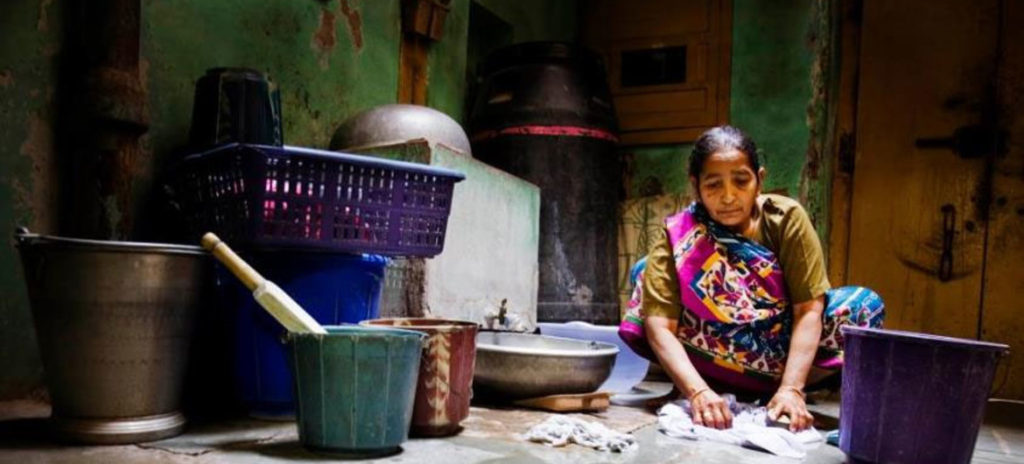Harasankar Adhikari
According to ILO Convention 189, domestic work is considered as “work performed in or for a household or households”. It varies according to the workplace (private household), and basically involves personal and household care for cooking, cleaning, taking care of children, the elderly and the disabled, attending to the garden or pets, or driving the family car and so forth. It is unorganized, unrecognized and unrewarding informal sector work. It is either part-time, full-time or on an hourly basis, and the worker may live in the home of the employer or not.
Domestic workers usually migrate from rural areas to urban areas. The number of female domestic workers is regularly increasing in urban India, despite the low wages and employment insecurity. Females of 15 to 35 years of age, of poor social and economic background, are engaged in this occupation. Unfortunately, their work is not considered as labour; so they are considered to be servants instead of workers. While these workers ‘spend their entire earnings on their families, yet they rarely have a say in the major family decisions.’
According to the ILO, ‘there are at least 67 million domestic workers over the age of 15 worldwide, 80% of which are women.’ As far as the situation in India is concerned, according to a report in The Wire,
“In 2010, Harish Rawat, the minister of state for labour and employment, accepted that there was no authentic data available on the number of domestic workers in India. According to the National Sample Survey (NSSO, 61st round 2004−05), the approximate figure of domestic workers in India was of 4.2 million. Before that, according to the 2001 census, it was around 6.7 million. The most recent government press release from January 2019 estimated (based upon NSSO 68th round 2011−12) the total number of domestic servants at 3.9 million.
“These numbers are contentious. In all likelihood, they conceal the extent of the workforce. First of all, these are based on survey estimates and are not exact enumeration. It will be pertinent to go back to Rawat’s interview to remain sceptical of this downward trend. Being a minister in the central government, he maintained that in his own conservative estimate, the total number of domestic servants in India would be around 15 million. He based his estimate on the fact that there were 30 million white-collared middle-class people in India and it’s a rarity that such a household would run without a maid. The media reports put the figure much higher – around 90 million. The ILO found the Indian case particularly ‘striking’ and ‘outstanding’ because of the vagueness of the number ranging from 2.5 to 90 million.”
According to a research by Human Rights Watch, domestic servants in India have to face extreme harassment (physical violence, sexual abuse, and in human behavior in the workplace). International Labour Organization (ILO) has called for a special attention to domestic workers, who have a right to “enjoy effective protection against all forms of abuse, harassment, and violence”. There is the urgent need to address the situation of female domestic workers. Due to lack of political and legal recognisation, they have to face potential harassment, discrimination, and exploitation at an alarming pace. They are now being confronted with increased hardships and financial challenges due to this COVID-19 pandemic.
For these domestic workers, the government has been vacillating in providing them legal protection. In order to safeguard the rights of the domestic woman workers, in 1959, a Bill called Domestic Workers (Conditions of Employment) was introduced, which could not be passed. A positive step was the inclusion of domestic workers in the Unorganised Social Security Act 2008, but the government did not implement its provisions properly. Only the Sexual Harassment against Women at Workplace Act, 2013 includes the female domestic workers to protect them from physical and sexual violence at the workplace. The Ministry of Labour and Employment released the first draft of the “National Policy for Domestic Workers” in 2011. But it got held up in the Parliamentary Standing Committee, and has still not seen the light of the day. In the same year, India signed the “Domestic Workers Convention C-189” of the International Labor Organization, which specified that domestic workers would enjoy certain basic rights, such as fair wages, regulated working hours, equal bargaining power, and so on. But the Indian government has yet to ratify it, which would then mean that it would have to take steps to implement its provisions. In June 2019, the Government of India announced that it was drafting a ‘national policy for domestic workers’, which would ensure the payment of minimum wages, social security and safe working conditions. But, it the draft has yet to become public, and there has been no word from the Centre regarding the issue since. Consequently, domestic workers have no safety net or grievance redressal mechanism to fall back on, while they need immediate protection.
Why is the government silent for this vulnerable sector, even though they have a significant contribution in Indian economy. The pandemic has considerably worsened their situation. Most of them have lost their jobs. Yet the government has not taken any steps to provide any kind of relief to them, except for providing them very inadequate rations in its relief package.




